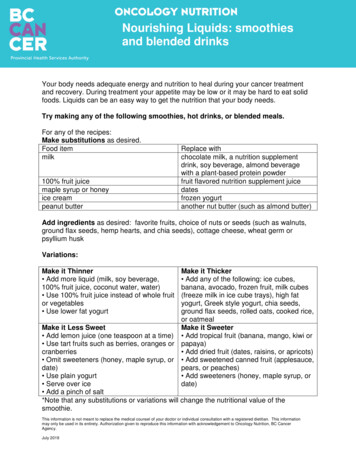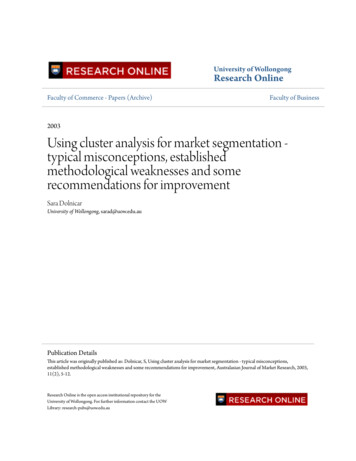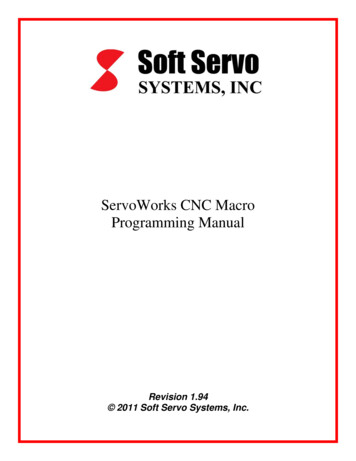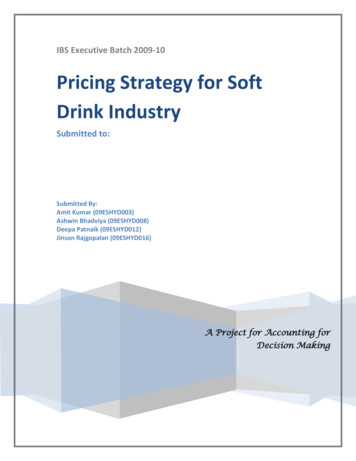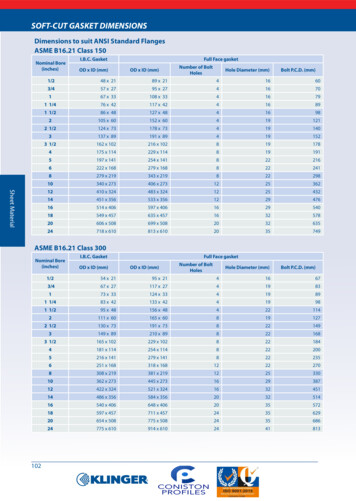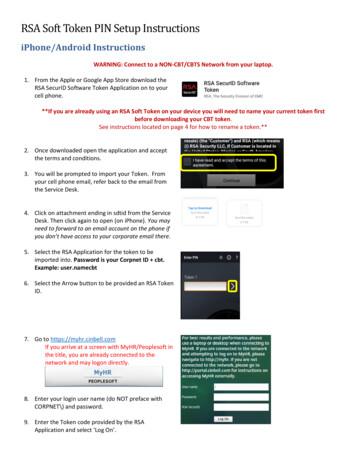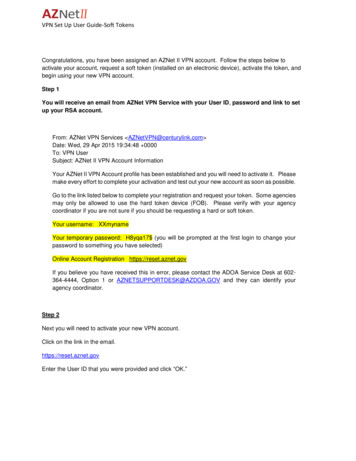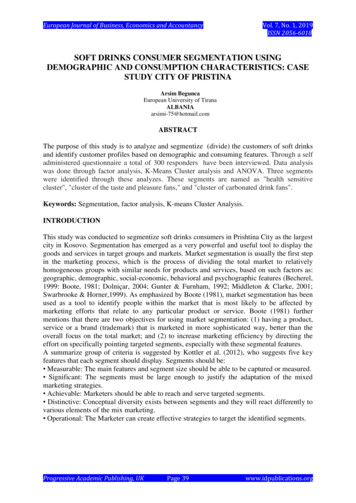
Transcription
European Journal of Business, Economics and AccountancyVol. 7, No. 1, 2019ISSN 2056-6018SOFT DRINKS CONSUMER SEGMENTATION USINGDEMOGRAPHIC AND CONSUMPTION CHARACTERISTICS: CASESTUDY CITY OF PRISTINAArsim BeguncaEuropean University of TiranaALBANIAarsimi-75@hotmail.comABSTRACTThe purpose of this study is to analyze and segmentize (divide) the customers of soft drinksand identify customer profiles based on demographic and consuming features. Through a selfadministered questionnaire a total of 300 responders have been interviewed. Data analysiswas done through factor analysis, K-Means Cluster analysis and ANOVA. Three segmentswere identified through these analyzes. These segments are named as "health sensitivecluster", "cluster of the taste and pleasure fans," and "cluster of carbonated drink fans".Keywords: Segmentation, factor analysis, K-means Cluster Analysis.INTRODUCTIONThis study was conducted to segmentize soft drinks consumers in Prishtina City as the largestcity in Kosovo. Segmentation has emerged as a very powerful and useful tool to display thegoods and services in target groups and markets. Market segmentation is usually the first stepin the marketing process, which is the process of dividing the total market to relativelyhomogeneous groups with similar needs for products and services, based on such factors as:geographic, demographic, social-economic, behavioral and psychographic features (Becherel,1999: Boote, 1981; Dolniçar, 2004; Gunter & Furnham, 1992; Middleton & Clarke, 2001;Swarbrooke & Horner,1999). As emphasized by Boote (1981), market segmentation has beenused as a tool to identify people within the market that is most likely to be affected bymarketing efforts that relate to any particular product or service. Boote (1981) furthermentions that there are two objectives for using market segmentation: (1) having a product,service or a brand (trademark) that is marketed in more sophisticated way, better than theoverall focus on the total market; and (2) to increase marketing efficiency by directing theeffort on specifically pointing targeted segments, especially with these segmental features.A summarize group of criteria is suggested by Kottler et al. (2012), who suggests five keyfeatures that each segment should display. Segments should be: Measurable: The main features and segment size should be able to be captured or measured. Significant: The segments must be large enough to justify the adaptation of the mixedmarketing strategies. Achievable: Marketers should be able to reach and serve targeted segments. Distinctive: Conceptual diversity exists between segments and they will react differently tovarious elements of the mix marketing. Operational: The Marketer can create effective strategies to target the identified segments.Progressive Academic Publishing, UKPage 39www.idpublications.org
European Journal of Business, Economics and AccountancyVol. 7, No. 1, 2019ISSN 2056-6018LITERATURE REVIEWMARKET SEGMENTATIONMarket segmentation is one of the basic principles of modern marketing, set deeply inmicroeconomic theory and that pays particular attention (importance) to the consumer needs.In market segmentation, potential customers (consumers) are divided into several segmentswith similar desires and needs (Boley and Nickerson,2012; Canhoto,Clark dheFennemore,2013).Consumer grouping practice or the process of total market share (usually heterogeneous) inmeaningful sub-markets (of homogeneous groups) based on needs or preferences for theproduct- with members who have needs, features or similar behaviors (Amue,Abiey andIgwe,2012; Birjandi,Hamizadeh and Birjandi,2013; Golma,2014; Kabyoh,2017).The basic purpose of market segmentation is to divide consumers into different groups, suchgroups that marketing messages are adapted to their specific needs by creating a narrowerreach between customer needs and market offering (Press and Simms,2010; Singh,2010).Market segmentation assumes that the market for any product or service can be divided intosubmarkets or segments, in such way as a meaningful group of buyers, each with their ownneeds, desires or discrete preferences. On the other hand segmentation is an aspect ofmarketing management concepts that deal with STP strategies (segmentation, targeting andpositioning) (Ateboh and Briggs,2014).Market segmentation is a process of dividing consumers into groups, respectively segmentswithin which consumers with the same features have similar needs. Based on this therespective mixed marketing can be orientated in order to reach everyone individually.Segmentation is a creative and renewable process in order to satisfy customer needs and atthe same time creating competitive advantages for the company. Segmentation contributes toa better identification of new production opportunities and the market in general.Segmentation is the basis for efficient marketing planning, which presents the orientationtowards the buyer rather than the orientation towards production. Segmentation is actuallydisplay of the similarities between certain consumer groups and the identification of theseparticular homogeneous consumer groups. Segmentation is also a division of the market insmaller parts, in which certain consumer groups are homogeneous and where each part is thetarget chosen as a separate part of the market in which the appropriate marketing strategy canbe concluded. The market part that is derived from this way is called a market segment, asub-market or a target market (marked markets).The organization/company that decides to operate in a particular market in most cases findsthat it is not able to supply products to all customers in that market, since the buyers are: Numerous; Spread in space unequally; They have heterogeneous needs and demands when purchasing the products.Therefore, organizations/companies will in some cases have a better position if they only dosupplying for some market segments. A certain company, rather than competing throughoutthe whole market, can identify some of its more attractive parts and thus more effectivelymeet the needs and demands of consumers. But, companies have not always taken such astand on the market. Their stances have gone through three stages, which are (Ph.Kotler,2013):Progressive Academic Publishing, UKPage 40www.idpublications.org
European Journal of Business, Economics and AccountancyVol. 7, No. 1, 2019ISSN 2056-60181. Massive market (mass market/bulk market). In some situations the organization/companyhas chosen the entire market as its target market. For organizations that prepare only onecombination of marketing mix for all potential customers in the market, it is supposed theyhave embraced the mass market approach. The starting point for this approach is that allconsumers in that market have similar needs and desires, that efficiently can be fulfilled onlyby one combination of the marketing mix (with standard product, similar prices, with a wayof distribution and a combination of the promotion forms) for the whole market. Thus, forexample, at one time Coca-Cola has acted according to this market approach, it producedonly one kind of beverage for the entire market, hoping that it will be right (will be suitable)to every consumer. The reasoning of this approach is based on the assumption that the massmarket enables the production and finalization of products with lower costs per unit ofproduction, offers products at lower prices and creates a greater potential market.Nevertheless, companies are increasingly faced with the fact that in the final market andbusiness consumer market, two customers are never exactly the same. Different individualsand organizations have different characteristics, needs and desires, which fulfill them invarious forms. Consequently, we have the situation when a product meets the needs ofconsumers in a small number of markets. The wide range of products on supermarket shelvesexpresses the wide range of customer needs. From this we perceive that the market is facing atendency opposite to that of the mass market approach. Thus, even in markets thattraditionally have been undifferentiated, changes are happening, that are noticed byincreasing the number of products being offered on the market. Mass market approachaccording to some probabilities can be used in only two cases. The first case is when thedifferences between consumer needs for certain products are very small, and this happensrarely. The second case is when the company/organization develops and wishes to maintainonly one combination of mix marketing tools that will meet the needs of all consumers.2. Products differentiation. The company/organization which bases its business on the basisof the products differentiation approach produces two or more different products. Theseproducts differ by their attributes, shape, size, design, etc. For example, nowadays Coca-Colaand other non-alcohol beverage manufacturers produce some types of drinks packed indifferent packaging. These products are produced in order to provide consumers withdifferent choices to satisfy meet their needs.3. Target marketing. In cases where the two previous approaches are shown to be inefficientand impractical, the company/organization will use market segmentation as more efficientapproach to better meet customer needs. This approach implies finding the consumerscommunity that has similar needs and behaviors when purchasing products. By knowing andunderstanding them, the company/organization can produce products that are only destinedfor that customer community.Therefore, companies from a large number of market segments will choose one or a few ofthem and develop a mix marketing strategy for each segment separately. For example, CocaCola produces soft drinks intended for consumers who are diabetic. Markets whereconsumers have different needs are named different markets. For example, the clock marketis largely a volatile market. The Timex Company offers consumers modern, practical andinexpensive clocks/watches, while Rolex offers them designed and exclusive watches.The only way to satisfy all customer needs in different markets is to offer productsmanufactured according to customer orders. Such a situation may arise in the businessmarket, where, for example, a machine required for work on the ward/work division isproduced according to the precise order received from its ordering party. These cases are ofcourse rare. In most of markets, customers are classified into groups that have similar needs,Progressive Academic Publishing, UKPage 41www.idpublications.org
European Journal of Business, Economics and AccountancyVol. 7, No. 1, 2019ISSN 2056-6018desires and requirements for the particular product. Therefore, market segmentation is aprocess through which market customers are classified into smaller, comparable and similarsegments. During this process, the company attempts to create a balance between the size andthe similarity of segments in order to combine the mix marketing tools more effectively.SOFT DRINKS MARKETSoft drink is a drink that typically contains sparkling (carbonated) water, sweeteners andnatural or artificial flavoring. Sweeteners can be sugar, high fructose cereal syrup, fruit juice,sugar substitutes (in case of dietary drinks) or a combination of them. Soft drinks can containcaffeine, colors, preservers and other ingredients. Soft drinks, each from a class of nonalcoholic beverages, usually but not necessarily carbonated, normally contain natural orartificial sweetening agents, nutrient acids, natural or artificial flavors and sometimes fruitjuice. Natural aroma is derived from fruits, nuts, berries, herbs and other plant sources.Coffee, tea, milk, unroasted (undiluted) fruit and vegetable juice are not considered softdrinks.The term ‘refreshing drink’ is created to distinguish aromatized/flavored drinks from strongalcoholic beverages and spirits. The refreshment/soft drinks industry currently consists of twomajor production systems, which together bring soft drinks to the market. These two systemsfall in different categories: (1) Production of Flavored syrups and concentrates and (2)Refreshment / Soft drinks production.The supply chain is largely dependent on syrup producers as a leader for many operations.Most of soft drinks follow this cycle by moving from the syrup producer, fillers, distributors,traders and the final consumer. The industry as a whole is facing changes as a result of theeconomic downturn and changes in consuming issues due to increased health awareness.Marketing is an important component of the industrial chain, which is used to generatedemand and build customer loyalty. Marketing has experienced a number of changes over thepast five years due to the effort to reduce advertising to children, to introduce new types ofmedia and to refresh marketing messages for consumers who are looking for healthieralternatives.OBJECTIVES OF THE STUDYThe main purpose of the study is to highlight the demographic features of soft drinksconsumers and identify consumer profiles based on demographic and consumer features.The main objectives (targets) of the study are :1.Identifying soft drink consumer profiles in the City of Prishtina.2.Examining factors that influence the choise (selection).3.To find out how many market segments are there.4. Identify which are the segment profiles.3.1 Research questionsResearch question 1: What are the refreshment/soft drinks consumer profiles in the city ofPrishtina?Research question 2: What are the influencing factors in the selection of refreshment soft/drinks?Research question 3: How many market segments are there and what are their profiles?Progressive Academic Publishing, UKPage 42www.idpublications.org
European Journal of Business, Economics and AccountancyVol. 7, No. 1, 2019ISSN 2056-6018RESEARCH SAMPLEFowler (1993) noted that the decision on the sample size should be taken on a case by casebasis, linking the various goals
Keywords: Segmentation, factor analysis, K-means Cluster Analysis. INTRODUCTION This study was conducted to segmentize soft drinks consumers in Prishtina City as the largest city in Kosovo. Segmentation has emerged as a very powerful and useful tool to display the goods and services in target groups and markets. Market segmentation is usually the first step
